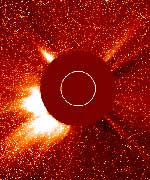
Image credit: SOHO
It started as the largest flare ever seen by the SOHO spacecraft, and only 19 hours later, the associated solar storm reached the Earth. The storm arrived as a G-5, the largest they get on the NOAA space weather scale. There was little disruption on Earth, however, with only some communications disrupted, and it appears that the Japanese might have lost contact with one of their satellites. Beautiful auroras were visible from many parts of the world, as far south in North America as Texas and Florida. People in Scotland reported that the aurora had already started when the Sun went down, and it was still going past midnight.
Forecasters at the NOAA Space Environment Center in Boulder, Colo., said that a powerful geomagnetic storm emitted from the sun sped though space at 5 million mph and reached Earth Wednesday 1:13 a.m. EST. NOAA space weather forecaster Larry Combs said, ?It took the geomagnetic storm just 19 hours to reach Earth after it occurred on the sun. That?s one of the fastest traveling solar storms this cycle.? The storm came in as a G-5 or extreme geomagnetic storm on the NOAA space weather scales, which run 1 to 5. (Click here to view larger image from the SOHO spacecraft of the intense solar activity on the sun taken Oct. 28, 2003, at 5:24 p.m. EDT. Click here to view high resolution version, which is a large file. Click here to view latest images. Please credit ?SOHO.?)
The solar flare caused an S-4 radiation event, which is the fourth largest in history since NOAA began keeping records in 1976. It?s also the second largest radiation event during this cycle of the sun.
Combs said, ?The geomagnetic storm is expected affect the Earth for the next 12 to 24 hours, but NOAA is forecasting that further major eruptions in these active regions of the sun will continue for the next week.?
Reports received by NOAA indicate that power grids in the northern United States and Canada are feeling the effects of the extreme geomagnetic storm. Utilities are experiencing power surges and are closely monitoring their systems. NOAA received a report that the Aurora Borealis, or northern lights, were visible as far south as El Paso, Texas.
?The NOAA Space Environment Center is home to the nation?s early warning system for solar activities that directly affect people and equipment?, explained retired Navy Vice Admiral Conrad Lautenbacher, undersecretary of commerce for oceans and atmosphere and NOAA administrator. ?Big solar storms like the current one can create brilliant northern lights but can also threaten with increased exposure to X-rays, damage and disrupt communications, energy delivery systems and aviation operations. SEC?s 24 hour-a-day, 7 day-a-week operations are critical to protecting space and ground-based assets.?
Through the NOAA Space Environment Center, NOAA and the U.S. Air Force jointly operate the space weather operations center that continuously monitors, analyzes and forecasts the environment between the sun and Earth. In addition to the data gathered from NOAA and NASA satellites, the center receives real-time solar and geophysical information from ground based-observatories around the world. The NOAA space weather forecasters use the data to predict solar and geomagnetic activity and issue worldwide alerts of extreme events.
The NOAA Space Environment Center plays a leadership role in the space weather community and helps foster a space weather services industry.
NOAA is dedicated to enhancing economic security and national safety through the prediction and research of weather and climate-related events and providing environmental stewardship of the nation?s coastal and marine resources. NOAA is part of the U.S. Department of Commerce.
Original Source: NOAA
